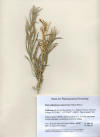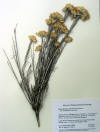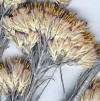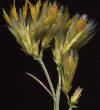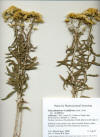Taxonomic Note: Previously updated (Oct 2006) according to treatment in Flora North America. In California, the genus Chrysothamnus has been previously recognized by the graduated phyllaries in vertical ranks, in contrast to the imbricated phyllaries that characterized the old genus, Haplopappus, which has been split up into many genera (Ericameria, Harzardia, Isocoma, etc.). The old taxonomic treatment still seems practical even though it may not truly reflect the phylogeny of the group. Ericameria nauseosa returned to Chrysothamnus (May 2013) |
|||
|
Chrysothamnus nauseosus
var. bernardinus |
Chrysothamnus nauseosus
var. ceruminosus |
Chrysothamnus nauseosus
var. graveolens |
Chrysothamnus nauseosus
var. hololeucas |
|
Chrysothamnus nauseosus
|
Chrysothamnus nauseosus
|
Chrysothamnus nauseosus var. junceus |
Chrysothamnus nauseosus var. junceus
|
|
Chrysothamnus nauseosus
var. mohavensis
|
Chrysothamnus nauseosus
var. mohavensis |
Chrysothamnus nauseosus
var. mohavensis |
Chrysothamnus nauseosus var. oreophilus
|
|
Chrysothamnus nauseosus
var. oreophilus |
Chrysothamnus nauseosus
var. oreophilus |
Chrysothamnus nauseosus
var. speciosus
|
Chrysothamnus nauseosus
var. speciosus |
|
|
Chrysothamnus
nauseosus
|
Chrysothamnus
viscidiflorus ssp. viscidiflorus |
Chrysothamnus
viscidiflorus ssp. viscidiflorus
|
|
Trees and Shrubs of Kern County (Sep 2012, Oct 2013, Jan 2014) Chrysothamnus Except for C. viscidiflorus, the species below have been included in Ericameria, (Nesom & Baird 1993, Phytologia 75: 74–93); however, some are still recognized here in Chrysothamnus by the white felt hairs on stems and blade-like or ribbon-like leaves. The bracts (phyllaries) of the floral head arranged in vertical ranks seems also distinctive for the genus; however, some closely related species such as C. parryi (Roberts 2002) have bracts that overlap more along their margins than aligned in vertical rows, while also distinguished by “subequal” bracts in which the lower bracts are longer and reach the same height as the upper except some varieties. In FNA (2006: 20), the key to Astereae seems to have omitted Ericameria from genera having phyllaries “disposed in vertical ranks” while Urbatsch, Anderson, Roberts & Neubig mentioned the character attribute in the genus description. In JM2, Ericameria keys out in five places, which further indicates the difficulty in defining the genus. Ericameria also includes many other species formerly in Haplopappus, which had been generally viewed as a heterogeneous assemblage of species (Cronquist 1994, Intermountain Flora, Vol. 5). Essentially, the problem that was seen in Haplopappus seems to have been transferred to Ericameria, although a number of smaller genera have been reinstated such as Hazardia and Isocoma. Petradoria pumila, a bushy perennial, generally not known west of the eastern Mojave Desert, may occur on Piute Mt. based on plants observed with developing leaves and remains of past year flowering stems.
1. Leaves best
developed just below flower heads, strongly
1. Leaves less
developed near flower heads, straight to slightly twisted;
2. Involucral bracts
overlapping along margins in 4–6 graduated ranks;
2. Involucral bracts
aligned in 3–5 vertical ranks; shrubs
3. Leaves and stems equally
white hairy...............
................................................ 4
4. Bracts short-tapered
(obtuse–acute); corolla lobes 0.5–1 mm... var. hololeucus
5 Stems leafy at
flowering; many leaves more than 3
cm...................................... 6
6. Leaves grayish
green, long threadlike, channeled, involucres
7. Involucres sharply
angled, 8.5–12 mm; bracts erect, acute...... var. mohavensis
Chrysothamnus nauseosus (Chrysocoma nauseosa Pallas 1814) Britton 1898 [Ericameria nauseosa G. Nesom & G. Baird]. Rubber rabbitbrush. Rounded subshrubs or shrubs with numerous stems up to 2 m; stems mostly erect, whitish green, covered with white felt-like hairs; leaves flat but narrow, usually >10× longer than wide, reduced in length in some varieties (mostly outside Kern Co.; var. mohavensis, junceus, turbinatus, uintahensis), flexuous or wavy but rarely twisted, soft hairy (felt-like). Flowering in the summer and fall; flower heads 2–10 on a main branch arising on shorter terminal peduncle-like branchlets; involucral bracts often straw colored near margins, in well-defined 4–5 vertical rows [except var. glareosus (northern Utah)] with the bracts increasing in length in each row, greenish near apex; Widespread and common, southern British Columbia to Saskatchewan, south to northern Mexico. Rubber rabbitbrush scrub recognized in MCV2 when ≥ 2% absolute cover or >25% relative cover in the shrub canopy. Type from the Missouri River. Divisible into as many as 21 varieties, 8 in California 2 of which are endemic, 6 in Kern Co. var. bernardinus H. M. Hall 1919. Stems leafy, white hairy; leaves green, blade-like and slightly sickle-shaped, wide spreading in various directions, often abruptly downturned (recurved) near tip, 2.5–6.0 cm long, 1–2 mm wide; involucres 10–13 mm; bracts with sessile glands, fringed, acuminate. Dry benches 6,000–9,500 ft, forests of ponderosa pine, Jeffrey pine, and red fir; San Jacinto, San Bernardino and San Gabriel Mts. north to Mt Pinos and east slopes of Sierra Nevada. Type from Bluff Lake, San Bernardino Mts.] Kern Co.: Frazier Mountain Park, Tejon Mts., 1400 m; E-face of Spanish Needle Peak, Owen's Peak Wilderness along eastern slope of the Sierra; San Emigdio Mts., Chula Vista Camp, Mt. Pinos, 7,800 ft; Mt. Breckenridge, 1,828 m (CCH). var. ceruminosus (Linosyris ceruminosus Durand & Hilgard 1855) H. M. Hall 1919. Stems and leaves yellowish green hairy; leaves < 1 mm wide, soon deciduous; involucral bracts recurved near apex. Gravel washes in the Mojave Desert, Tejon Pass to Little San Bernardino Mts., 2,400–5,500 ft. Type from near Tejon Pass, CA. Kern Co.: “Common and autumnally colorful on the sand slopes on the ridges between Jawbone Canyon and Kelso Valley.” Also, “Kern Canyon from Kernville well into Tulare County.” “Common in the Lamont Meadow region on the southeastern corner of the Kern Plateau in Tulare County near the Kern County line. Type from Tejon Pass (Twisselmann). var. hololeucus (Bigelovia graveolens A. Gray 1873 var. hololeuca A. Gray 1873) H. M. Hall 1919. Corolla lobes relatively short, <1.5 mm; involucral bracts yellowish green, 6–7 mm, obtuse, keeled. Sandy neutral soils of desert regions, 3,000 to 9,000 ft., primarily in the Great Basin Desert. Type from Owens Valley, CA. Kern Co.: “Common on the desert, even in very arid and often subalkaline places, southwest through the pinyon woodland to Cuyama Valley; west to Kernville (where it is common about the town); rare in the southern Temblor Range (Recruit Canyon, Grocer Grade).” Scattered on the west slope of the Greenhorn Range on ridges in well developed Douglas oak woodland (Twisselmann). var. mohavensis (Bigelovia mohavensis Greene 1884) H. M. Hall 1919. Shrub 0.5 to 2 m high; stems leafless or leaves 10–30 mm, <1 mm wide; pericarpia hairy; fastigiately branched; involucre narrow, 8–10.5 mm, sharply 5 angled. Well-drained soils, 2,500–6,000 ft, woodlands and desert scrub, scattered locations, northern, central, and southern part of the Great Valley, Transverse Ranges to San Jacinto Mts., southern Sierra Nevada to White Mts. to southwestern Utah. Type from the Mojave Desert, CA. Kern Co.: “Occasional in the Mojave Desert, head of Nine Mile Canyon in Inyo County south through the pinyon woodland and the arid shrub association to the western Mojave Desert in Antelope Valley and the Douglas oak woodland at Lebec.” “Common around Wofford on the east slope of the Greenhorn Range” (Twisselmann). var. oreophilus (Chrysothamnus oreophilus A. Nelson 1912) H.M. Hall 1919 [Includes var. consimilis (E. Greene) H. M. Hall]. Shrubs < 0.5 m, grayish, yellowish or white hairy; leaves threadlike, yellowish green when young, grayish in age or upon drying, 2–5 cm long, < 1 mm wide, erect or variously spreading, twisted or coiled or curved; involucre 6.5–9 (-10) mm, bracts acute to obtuse, lacking hairs and glands. Generally alkaline places in the Great Basin Desert. Type from Evanston, WY. Kern Co.: “The common rabbit brush of the pinyon woodland, occasionally extending to the Jeffrey pine forest” (Twisselmann as var. consimilis). Indian Canyon, north end of Rosamond Lake, South Fork Kern River bridge on Weldon-Kernville road; 5.8 mi e of Landers Meadow (Harris Grade, e slope of Piute Mountain (CCH). var. speciosus (Chrysothamnus speciosus Nuttall 1841) H. M. Hall 1919 [Includes C. speciosus var. albicaulis Nuttall; C. nauseosus ssp. occidentalis (Greene) Hall]. Leaves present at flowering; involucre 7–10 mm, bracts acute to acuminate. Type from Rocky Mts. plain near Lewis River. Kern Co.:”Common and picturesque at high altitudes, often around exposed summits (Breckenridge Mountain, Piute Peak, Tehachapi Peak, and Mt. Abel” (Twisselmann). Chrysothamnus parryi (Linosyris parryi A. Gray 1863) Greene 1895 var. vulcanicus Jepson 1925. Parry's rabbitbrush. Primarily in the southern Sierra Nevada with a disjunct occurrence near Mammoth Lakes. Parry’s rabbitbrush scrub recognized in MCV2 when >3% absolute cover. Type from Volcano Creek above Volcano Falls, Tulare Co., CA. Kern Co.:”Common in the Jeffrey pine forest in the Piute Mountains, especially on the extensive sagebrush flats; scarce in the Greenhorn Range,” south side of Cooks Peak, and near Tiger Flat (Twisselmann), 1,982–2,561 m (CCH). The species generally occurs on montane desert slopes from Nebraska to central Idaho, southeastern Oregon, south to New Mexico and southern California. Chrysothamnus viscidiflorus (Crinitaria viscidiflora Hooker 1834) Nuttall 1841 var. viscidiflorus. Yellow rabbitbrush. Generally east of the Cascades/Sierra Nevada ranges to the Rocky Mountains (3,500-) 6,000–9200 ft; most common in the southern Rocky Mts. Type from barren plains of the Columbia, from the Great Falls to the mountains. Kern Co.: Owens Peak, Scodie Mt., Greenhorn Range-Black Mt, Piute Mt. east side of Bald Eagle Peak, Ft. Tejon State Park, Mt Pinos, San Emigdio Range, Mt Abel (CCH); “occasional in the chaparral on the north end of Piute Mountain and common in granite in the Jeffrey pine forest along the crest of the mountain.” Also “roadside on the south side of Black Mountain at 3,500 ft in the Greenhorn Range where perhaps adventive.” “Piute plants are a mass of cheerful yellow” in the fall, especially when there has been a good summer rainfall” (Twisselmann), 1,000–2,800 m (CCH).
References on Pharmacological Activity in Chrysothamnus Ahmed A. A., M. E. Hegazy, N. M. Hassan, M. Wojcinska, J. Karchesy, P. W. Pare and T. J. Mabry. 2006. Constituents of Chrysothamnus viscidiflorus. Phytochemistry 67(14):1547–1553. “A phytochemical investigation of the aerial parts of Chrysothamnus viscidiflorus var. viscidiflorus afforded three new [chrysothol (1), 2 and 4] and seven known compounds, including five sesquiterpenes, two cinnamic acid derivatives, two ketoalcohol derivatives and one coumarin glucoside. The structures of two previously reported compounds, 1b and 1c, were revised on the basis of chemical reaction. Structures of the compounds were determined by extensive NMR studies, including DEPT, COSY, NOE, HMQC, HMBC and X-ray analysis. The unpublished X-ray data of the known compounds 6 and 7 are reported. Compounds chrysothol (1), and 8-10 showed anti-cancer activity against human breast cancer cells.” |
|||






